Figures & data
Table 1. Examples of ungrammatical sentences of the five syntactic structures, respectively.
Figure 1. Overview of the 2 experimental lists (Regular-Silence-Irregular and Irregular-Silence-Regular) used in Experiment 1. One 32-s rhythmic prime or period of silence was always followed by 6 sentences (3 common object relatives, 1 transposed object relative, 1 subject-verb-object sentence and 1 complement clause or subject relative; of which 3 grammatical and 3 ungrammatical). Eight miniblocks of the same musical prime were grouped into one block. Based on the order of presentation of the regular and irregular primes, and the two experimental lists were constructed and administered to two groups of participants, respectively
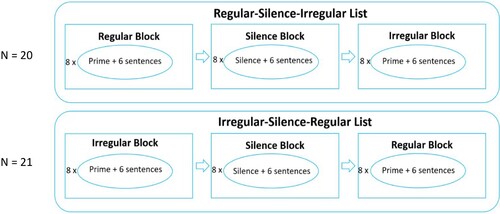
Figure 2. No significant main effect of Prime on grammaticality judgement d’ in Experiment 1. The dots connected by dashed lines represent individual participant d’ in the regular, silence, and irregular conditions, respectively.
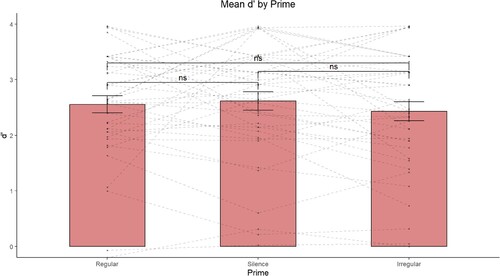
Table 2. Summary of fixed effects obtained using the summary(model) function of the lme4 package in R. Model: D’ ∼ Prime + 1|Participant.
Table 3. Main effects and interactions obtained using the anova(model) function in R. Model: D’ ∼ Prime + 1|Participant.
Figure 3. Significant Prime × Miniblockhalf interaction in Experiment 1. Resolving the interaction reveals that in the first Miniblockhalf, d’ in the Irregular condition were significantly lower than in the Regular and Silence conditions, with no significant differences between the Regular and Silence conditions. In the Second Miniblockhalf, no significant differences were found between the Prime conditions. Furthermore, d’ after Silence were significantly higher in the First Miniblockhalf than in the Second, d’ in the Regular condition showed a trend in the same direction, while d’ in the Irregular condition showed a trend in the opposite direction.
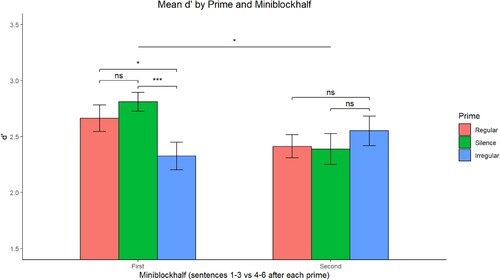
Figure 4. Significant Prime × Order interaction in Experiment 1. Resolving the interaction reveals significantly lower d’ after an Irregular prime than after a Regular prime or Silence in the Irregular-Silence-Regular Order, but no significant differences between Prime conditions in the Regular-Silence-Irregular Order. Furthermore, participants having completed the experiment in the Irregular-Silence-Regular Order underperformed those having completed the Regular-Silence-Irregular Order in the Irregular condition, but not after a Regular prime or Silence.
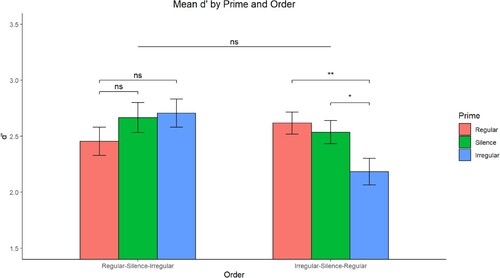
Table 4. Summary of fixed effects obtained using the summary(model) function of the lme4 package in R. Model: D’ ∼ Prime*Miniblockhalf*Order + 1|Participant.
Table 5. Main effects and interactions obtained using the anova(model) function in R. Model: D’ ∼ Prime*Miniblockhalf*Order + 1|Participant.
Figure 5. Example of one of the 6 experimental lists used in Experiment 2. One 32-s rhythmic prime or period of silence was always followed by 6 sentences (3 common object relatives, 1 transposed object relative, 1 subject-verb-object sentence and 1 complement clause or subject relative; of which 3 grammatical and 3 ungrammatical). Three miniblocks of the 3 different prime conditions were presented in an alternating order, which remained the same throughout the experiment in a given list. Based on the order of presentation of the prime conditions (8 × (Regular-Silence-Irregular), 8 × (Regular-Irregular-Silence), 8 × (Irregular-Regular-Silence), 8 × (Irregular-Silence-Regular), 8 × (Silence-Irregular-Regular), 8 × (Silence-Regular-Irregular)), six experimental lists were constructed and distributed evenly across participants

Figure 6. No significant main effect of Prime on grammaticality judgement d’ in Experiment 2. The dots connected by dashed lines represent individual participant d’ in the regular, silence, and irregular conditions, respectively.

Table 6. Summary of fixed effects obtained using the summary(model) function of the lme4 package in R. Model: D’ ∼ Prime + 1|Participant.
Table 7. Main effects and interactions obtained using the anova(model) function in R. Model: D’ ∼ Prime + 1|Participant.
Figure 7. Significant Prime × Miniblockhalf interaction in Experiment 2. Resolving the interaction reveals that in the first Miniblockhalf, d’ after a Regular prime were significantly higher than after an Irregular prime, with no significant differences between the other two conditions. In the Second Miniblockhalf, d’ after a Regular prime were lower than after Silence, with no significant differences between the other conditions. Furthermore, d’ after a Regular prime were significantly higher in the First Miniblockhalf than in the Second, while there were no significant differences between the First and Second Miniblocks in the Irregular and Silence conditions.
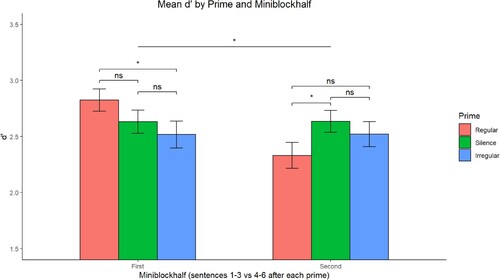
Table 8. Summary of fixed effects obtained using the summary(model) function of the lme4 package in R. Model: D’ ∼ Prime*Miniblockhalf + 1|Participant.
Table 9. Main effects and interactions obtained using the anova(model) function in R. Model: D’ ∼ Prime*Miniblockhalf + 1|Participant.
